It is possible that someone has broken my twenty year old record for the largest rainbow trout ever taken by fair means in the state of Alabama, but if so I have never heard of it. My only witness was a high school classmate whom I had sworn to secrecy, and I released the record fish, and never caught it again. Out of fear that the spectacular limestone creek where that fish and a few others like him lived would be overrun with fishermen, I told only a few, very trusted people, no more than three or four over twenty years. I did not know, although I should have, that by keeping the secret of those big trout, I would guarantee the destruction of a creek that once meant more to me than any other place on earth.
I have lived away from Alabama now for nine years. I miss the landscape and the rivers there, the birds and fish and wild game, the weather, and the color of the soil in the fields.It can be said that I left because I couldn’t take what was being done to that landscape as the human population grew, as we changed from the South into the Sunbelt, mowing down the hardwood forests, planting every clearcut in pine, allowing the pollution of the Alabama River, the Tennessee, turning the beautiful Tombigbee into a ditch, begging for more industry, more people, more of everything. I still feel like an exile, and I do not admire exiles. I admire the person who stays at home and makes an honorable fight of it on their home ground. That I have not done this causes me some unrest.
Last week, my mother called me, and at the end of our conversation, she told me that a new county water supply system was going to be built on Mountain Fork Creek. “It is really growing out that way,” she said, “and what they’ve done to that creek is just a tragedy. The new plant is going to cost $8 million. I remember when we first took you there, you must have only been three or four ... We loved it so ...” After I hung up the phone, I wallowed for a few minutes in a steadily building rage. There was fear, too, a perhaps unreasonable fear that it is possible to be done in by the outrages heaped upon the places in a person’s life that have instructed and formed them, have offered them visions of the rightness of time, and God, and nature. I gradually settled down, and I started to type. It is no longer necessary, or even right, to keep secret the story of the Alabama state record rainbow, or of Mountain Fork Creek and the transcendent days that I spent fishing its cold waters.
The Mountain Fork is a tributary of the Flint River, in Madison County, north Alabama. It rises from a series of limestone springs on Coal Mine Mountain, and follows a shelf of rock at the base of Backbone Mountain, where it is joined by several more springs. There is a narrow wooden footbridge over this part of the creek, and fallen cabins on the hillsides far from the road. The cabin directly across from the footbridge is shaded by an immense age-wrecked beech tree. It was built by a man who had received the land for fighting honorably in the American Revolution. The land is mostly in pasture, plowed to cropland in the flats along the creek. The water is clear and not yet too cold for shellcrackers and redeye bass, and there is an annual spring run of silver redhorse from the faraway Flint. As the creek moves away from Backbone Mountain, it merges with the vast output of a spring that issues from the mouth of a cave about twenty feet across. The cave water is very cold and very mineralized, and it changes the life in the creek. Strange sculpins and darters the color of gemstones shift in schools through black mosses and patches of watercress two feet high. Hellbenders stir the rocky bottoms of the deeper holes, drifting under glittering masses of shiners and big hornyhead chubs. Few bullfrogs, and fewer water snakes, choose to live in the chill, although the delicate tan queen snake, seldom seen on the warmer creeks, is common here. Approaching the creek on a summer day you walk across flat, hot pastures, breach a chiggery thicket of blackberries and green ash and Johnson grass growing in the shade of the big oaks and hackberries that edge the fields and then you pass abruptly into the chill from the creekwater, like entering a shadowed, air-conditioned room. The smell is momentarily overwhelming, flowering wild mint, horsemint, watercress, moss, wet rock, jewelweed, mussels. The watercress out toward the channel shivers with the current. The long streamers of moss twist downstream. The sun falls filtered through the canopy of the trees and lights the rocks on the bottom a deeper green than all the riot of green around you. It is as exotic in its way as any place on Earth.
Before the early 1970's, there was a trout farm on some acreage above the big feeder spring. They used some of the springwater to operate a series of ponds where they had rainbow trout, and they let people come and catch them and pay by the pound of fish taken away. I remember the picture of the beautiful trout on the wooden sign, and my absolute desire to fish there after it was pointed out to me by my parents, who even then were fascinated by the cold creek and the land around. I don’t think I ever got the chance to fish the ponds, and during the years that followed the people who owned them moved away. It is a country of both drought and flood, and some great torrent may have breached the dams, or the people may have simply thrown a few of the trout into the creek. Whichever it was, the fish thrived there. Because that stretch of Mountain Fork is so cold that few of the more popular Alabama fish can live in it, no one fished there, and they went unnoticed, to grow old and heavy and hook-jawed, brilliantly colored, otherworldly.
More Like This
It has been my blessing in life to be obsessed with fish.
I don’t know the root of it. When I was twenty years old I was hired to work on a longline boat by a captain who said he was looking for a sportfisherman, primarily. “I want somebody who is obsessed with fish,” he said, “somebody who loves just to look at them. Somebody who thinks about them all the time, where they are, what they do when nobody is looking.” He was talking about me. When I was young, my obsession had phases-for awhile I hunted chain pickerel in small creeks along the Tennessee River, and it was something about the way they looked that inspired my awe. They were distinctly predatory, hovering at the edge of weed beds, tail slightly curved like a stalking tiger. The dark green symmetry of the markings on their sides was perfection itself. A small bullfrog or salamander, hooked through the hind leg and allowed to swim freely along in the current, brought them rushing forth. I worked out methods of taking bowfin and gar on topwater lures, and of course, I fished for bass and shellcrackers whenever I could find them. I loved trotlining and limblining, waking up in the mornings knowing that some fantastic bounty was waiting for me--big blue and flathead cats, buffalo, river drum, softshell turtles, all the denizens of the dark cutbanks and the shadowed gravel shoals brought up to light. As I ran the little rivers, checking limblines, I fished for smallmouth and redeyes, flipping a two inch floating Rapala up against the banks, twitching it slowly out to the edge of the current. Very few people knew that there were smallmouths in the little rivers, and I felt it was my bound duty not to tell them.
For anyone obsessed by fish, no matter where in the freshwater world you are born, trout loom on the horizon. It is easy to see them as the artistic summit of freshwater fish. They are predatory, muscled, and unbelievably beautiful. To hold in your hand a brook trout caught from a creek high in the Smokies is clearly to hold one of the greatest artworks of Creation. To look upon those intricate etchings of marble white and deep green, those spots of orange, haloed by electric blue, is to ask yourself the largest of questions. Why would a creature possess such beauty? For whom does such beauty exist, and by what design? Is the purpose of such color merely to inspire our awe? Are we the only animals that see such beauty? If so, what does that imply about our responsibilities? Looking at trout, it is not difficult for me to understand Van Gogh and his sunflowers, Gauguin and the light of Tahiti falling upon the skin of a dark woman.
I was obsessed with trout, the more so because when I was a child they were the denizens of clear water rivers far, far, away, in fairytale country, mountainous and cold and wild. I took the smallest hooks out of my father’s tackle box and tied gaudy flies with sewing thread and feathers gathered from around the birdfeeder, made a fly rod out of a piece of switchcane, and fished for shiners in a small, clear creek near home, pretending the shiners were trout, or Arctic char, or Atlantic Salmon. In much later years, in my early twenties, after I had fished some of the waters that I had dreamed of as a child, I carried the obsession a step farther, seeking trout where there were supposed to be none. An endless series of buses took me through Mexico and into Guatemala, across bridges blown by guerillas, through camps of soldiers, and towns of Indians where no one spoke Spanish, and up into the mountains, the Cuchumatanes, where I wandered the rushing creeks and rivers, fishing with flies and spinners and tiny plugs. It was an altiplano country of sheep and tussock grass and dense blowing fog, and the rivers spilled off its edge and entered impenetrable cloud forest. I never caught a trout there, although many people native to that place told me that they were there, and I believe them. In the end I traded my fishing gear for food and beer and gave it away as a gift to fishing children, and I went back north.
But in between the childhood dreaming and the free wandering fishing of my twenties there was Mountain Fork Creek. My family was living out in the country, in a broad cove set into the flat-topped foothills of the Southern Cumberlands. At fifteen I had access to a farm truck that I was allowed to drive on dirt roads and on back roads where there was little chance of hitting another car, and these back roads led along the edge of the mountains towards New Market, near the Tennessee line, and along the upper Mountain Fork. There was a bridge over the creek that had been very badly constructed, and it would wreck you if you hit it too fast. One May afternoon, as I crept over the bridge, I looked down into the water and saw a dense school of dace, rolling in an eddy behind the pilings. I stopped and got out and stood watching them. There were empty .22 cartridges all over the bridge, where someone had been shooting down into the water at snakes or turtles, which is standard practice there. The bottom of the creek was littered with shiny shot-up beer cans and broken glass and some old tires, encased in dramatic wigs of black moss, but the water was absolutely clear, and so cold that there were wisps of vapor rising from it into the hot afternoon. The creek flowed from the intense sunlight around the bridge into the shade of the trees as if it had entered a culvert, and its banks were undercut and overhung with a luxuriance of weeds. I remember the pale orange bells of jewelweed because I had used it as a poison ivy remedy while cutting red cedar for pulp the summer before, and I was always on the lookout for a new supply.
At the place where the water entered the shade, something rolled, flashing, then rolled again, and then rushed out into the sunlight and made a sweep through the dace. It was a pale green, spotted fish, about twenty inches long, and I thought that I knew what it was, although I had never seen anything like it before. I remembered the wooden sign with the painted trout, and the ponds, which would have been about four miles upstream. I had a spinning rod in the back of the truck, and a little packet of hooks and sinkers and I whipped the truck into a rough turnout below the bridge and frantically got the gear together.
The turnout, close by the cold creek, was a local party spot, and it was littered with more beer cans and the odd tossed rubber, flattened cigarette packs, Beanie Weanie cans, an unbelievable assortment of spent ammo. Somebody had dumped a pickup load of old tarpaper at the point where the turnout entered the thickets of the woods. I forked the slabs of tarpaper over, using a discarded curtain rod instead of my hands for fear of copperheads and ground hornets, and I caught a good sized nightcrawler right away. I hooked him up, pulled the sinkers off my line with my teeth, and free spooled him downstream. A shiner took him. I raced back to the pile of tarpaper, got another worm, let it drift down. It passed the undercut bank and swung in, and I saw a brief movement out of the shadows there. A hornyhead chub, thick, almost a foot long, rose and took the bait. I landed him fast, tried the whole action again, but the minnows attacked every time. I was not allowed to keep the truck out for long periods of time without my parents knowing where it was, so I reluctantly abandoned the creek and drove away home. A rusted out Chevy Nova station wagon, about a ‘66, fell in close behind me. Two wild-haired men were in the front seat, a big-headed yellow dog, pitbull or cur, sat in the backseat with its paws and head out the window. I hoped that they had not seen me fishing. They followed me for about a mile and then pulled a U-turn in the middle of the road, tossing a beer can out of the driver’s side.
I came back the next day, with two Rooster Tails and two Mepp’s Aglias that I had bought from the store at the Madison County Lake. I fished the hole under the bridge hard, but caught only minnows and an odd, pale colored shellcracker. The water on the upstream side of the bridge was very shallow, with a bottom of brown peagravel, so I skipped ahead, walking a hard-packed cattle trail in the shade of a grove of catalpa and bodock trees. The cattle had stripped most of the undergrowth, and the walking was easy. The creek was about fifty feet wide at this point, and no more than two or three feet deep. The cattle used it as a wallow, and they had cropped all the watercress that grew in the sandy shallows at mid stream. At a cross fence the land changed, and it was pastureland being fast reclaimed by thickets, ash, ailanthus, sumac, and dewberry.
I stepped into the water to avoid the thicket. The creek narrowed and made a long bend. In the corner of the bend a small hackberry tree had been undercut and fallen into the water. The current came against the bend and made a hole of green water, about four feet deep, the deepest part beneath the tree. I cast upstream and let the spinner tumble down toward me. Minnows followed, and I began to have my first doubts that what I had seen at the bridge was actually a trout. I knew that it could have been wishful thinking on my part. I had a very powerful imagination, and it had served me wrong before. I had spent two entire deer seasons haunting the incredibly uncomfortable branches of trees that overhung a particular gully that crossed our farm, convinced that a monster whitetail buck used the bottom of the gully to travel unseen between the soybean fields in the flats and the protection of the mountain timber. I never even saw his tracks, or the tracks of any other deer, in the gully, but I imagined, or dreamed, that he used it--it just seemed like the perfect place for a monster whitetail. I glumly watched skunks, coons, and possums trudge along below me, and I never killed a deer anywhere near there. Likewise, Mountain Fork seemed like such a perfect trout stream. It was mysterious, dark, overlooked, enfolded in thickets for much of its length. I knew it was possible that I had created that trout.
Continue to Part 2 of Mountain Fork Creek.





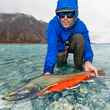
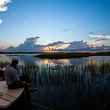



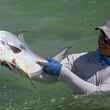
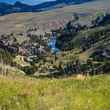



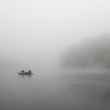




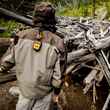
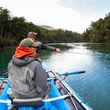



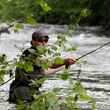





Comments
Christine replied on Permalink
Simply gorgeous writing. A deep bow to you, Hal Herring.
Pages